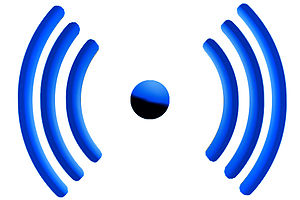 |
| Wi-Fi Signal logo (Photo credit: Wikipedia) |
Wi-Fi, also spelled Wifi or WiFi, is a popular technology that allows an electronic device to exchange data or connect to the internet wirelessly using radio waves. The Wi-Fi Alliance defines Wi-Fi as any "wireless local area network (WLAN) products that are based on the Institute of Electrical and Electronics Engineers' (IEEE) 802.11 standards". However, since most modern WLANs are based on these standards, the term "Wi-Fi" is used in general English as a synonym for "WLAN". Only Wi-Fi products that complete Wi-Fi Alliance interoperability certification testing successfully may use the "Wi-Fi CERTIFIED" trademark.
Many devices can use Wi-Fi, e.g. personal computers, video-game consoles, smartphones, some digital cameras, tablet computers and digital audio players. These can connect to a network resource such as the Internet via a wireless network access point. Such an access point (or hotspot) has a range of about 20 meters (65 feet) indoors and a greater range outdoors. Hotspot coverage can comprise an area as small as a single room with walls that block radio waves, or as large as many square miles achieved by using multiple overlapping access points.
Wi-Fi can be less secure than wired connections (such as Ethernet) because an intruder does not need a physical connection. Web pages that use SSL are secure but unencrypted internet access can easily be detected by intruders. Because of this, Wi-Fi has adopted various encryption technologies. The early encryption WEP, proved easy to break. Higher quality protocols (WPA, WPA2) were added later. An optional feature added in 2007, called Wi-Fi Protected Setup (WPS), had a serious flaw that allowed an attacker to recover the router's password. The Wi-Fi Alliance has since updated its test plan and certification program to ensure all newly certified devices resist attacks.
The name
The term Wi-Fi, commercially used at least as early as August 2000, was coined by a brand-consulting firm called Interbrand Corporation. The Wi-Fi Alliance had hired Interbrand to determine a name that was "a little catchier than 'IEEE 802.11b Direct Sequence'". Phil Belanger, a founding member of the Wi-Fi Alliance who presided over the selection of the name "Wi-Fi," also stated that Interbrand invented Wi-Fi as a play on words with Hi-Fi (high fidelity), and also created the Wi-Fi logo.
The Wi-Fi Alliance initially used the advertising slogan, "The Standard for Wireless Fidelity", for Wi-Fi but later removed the phrase from their marketing. Despite this, some documents from the Alliance dated 2003 and 2004 still contain the term Wireless Fidelity. There was no official statement related to the dropping of the term.
The yin-yang Wi-Fi logo indicates the certification of a product for interoperability.
Non-Wi-Fi technologies intended for fixed points such as Motorola Canopy are usually described as fixed wireless. Alternative wireless technologies include mobile phone standards such as 2G, 3G or 4G.


Conversion Conversion Emoticon Emoticon